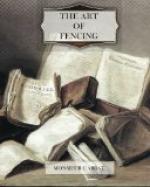If the Ground be uneven, or that you have a mind to surprize an unskilful Man by gaining Measure unperceived, or to oblige one, a little expert, to push at the time you advance your Body; you must, I say, if your Adversary is unskilful, bring the Left-foot more or less near the Right, as you are more or less out of Measure, which gains more Ground, and less visibly than the foregoing Demarche, and is more favourable to your Thrust: If your Adversary is a little expert, and pushes on this your advancing you must bring back the Left-foot to it’s Place, and he will be out of Measure, tho’ by Means of his Lunge you will be well in Measure, which is a great Advantage.
The same Demarche may be made in retiring, where the Ground is uneven, lifting the Right-foot, bringing it near the Left, and putting back the Left in Guard.
To make a Thrust in three Motions, being out of Measure, you must make a double Beat, which is done by a small Beat of the Right-foot in the same Place, beginning immediately with the same Foot to close the Measure.
The three Ways of retiring which I have shewn, are done from the Situation in Guard. The two which are done after a Lunge are, first by lifting and bringing the Right-foot back from the Place of the Lunge behind the Left, and then carrying the Left behind the Right, in order to be in Guard.
The late Monsieur De Latouche, and Monsieur De Liancour, found this demarche better than the following one, tho’ it is not so generally used.
The second Retreat after having pushed, is made by drawing back the Right-foot about the length of the Shoe, bending the Knees, in order to be in a condition to chace or drive back the Left-foot with the Right, keeping the Hams very supple, the Body free, and the Sword before you; not only that you may spring the farther, but also to be in a better Posture of defence. The Point of the Right-foot should come down first, leaning immediately after on the Heel; the Left-foot must fall on the Line at the distance, and in the Situation in Guard, as I before observed, in order to be ready to take the Time, or to make a Riposte.
The two Masters that I have quoted, condemned this Retreat very much, especially Monsieur De Latouche, who says in springing back, three motions are necessary; first to draw back the Right-foot in guard, secondly to bend the Knee, and thirdly to chace or fly back. Any Master, will find that there should be but two motions, it being easy to bend the Knees and draw back the Right-foot at the same Time.
Besides, his rule for springing back is false; for by drawing the Right-foot back so far as in guard; you lose Time, the first Motion being too long, and the Feet being so close together, the Body has not sufficient Strength, and consequently cannot go far. From this it is plain that three Motions are not necessary for springing back, there being but two in all. He likewise says that the leaping back, requires such




